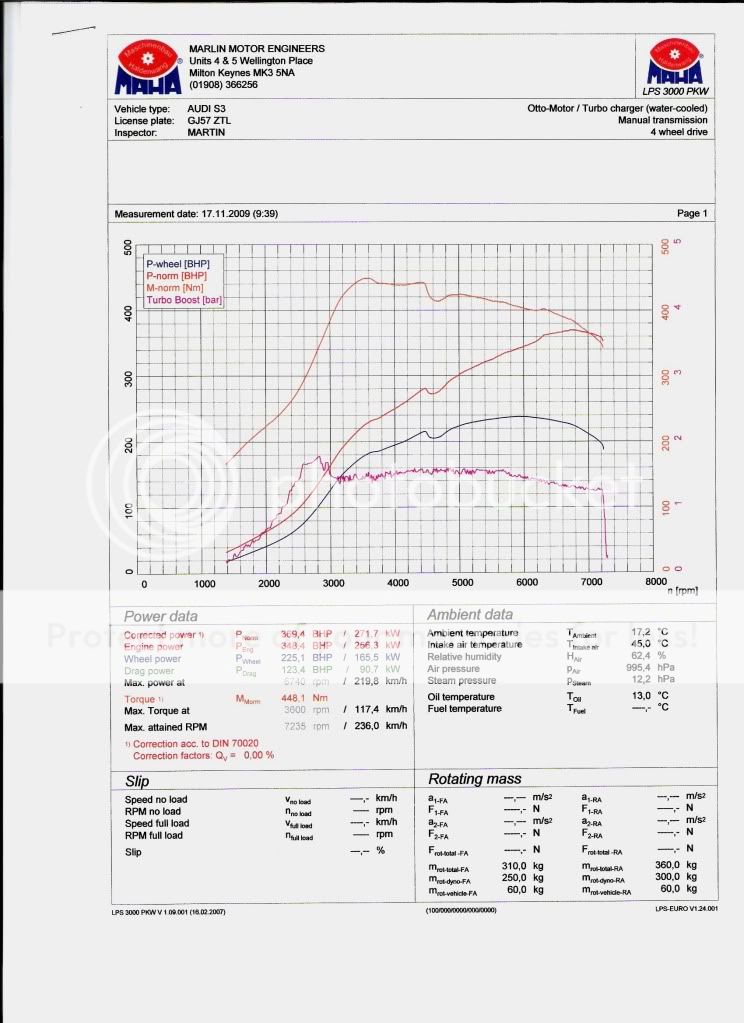The following calculation is how you arrive at the discharge temperature of the compressed air leaving the turbo. As you can see, part of that calculation requires you to know the inlet temperature of the incoming to the turbo. This alone, means that turbo inlet temperature does have a bearing on the turbo exit temperature or the overall efficiency of the turbo in regards to compressing the air(making boost).
Tout = Tin + Tin x [-1+(Pout/Pin)0.263]
______________________
efficiency
Tin=
70 deg F (this is the turbo inlet air temp) + 460 = 530 deg R
Pin= -0.5 psig (turbo inlet air pressure) + 14.7 = 14.2 psia
Pout= 19 psig (acheived boost pressure at turbo exit) + 14.7 = 33.7 psia
Pout/Pin = 33.7/14.2 = 2.373 (this is the compression ratio)
Tout = 530 + 530 x (-1+2.3730
.263 ) = 717.8 deg R - 460 = 257.8 deg F
___________________
0.72
So, this turbocharger above which has an efficiency of 72%, inlet temp of 70deg, inlet pressure of -.5 psig, a 2.373 compression ratio and an acheived boost pressure of 19 psig results in turbocharger exit temperatures of 257 deg.
Now, let's test the affect of inlet temperature on the exit temperature of the turbo. Leaving everything else static, let's change the inlet temperature to 80 deg.
Tout = 540 + 540 x (-1+2.3730
.263 ) = 731.38 deg R - 460 = 271.3 deg F
___________________
0.72
So, a 10 deg increase in turbocharger inlet temperature will result in a 13.5 deg increase in turbocharger exit temps for this particular turbo.
Also, please feel free to check my math as I don't consider myself a mathematician by any means, I work in Sales/Marketing.
Please note the original formula calls for
.263 to be an exponent of (pin/pout). I couldn't get that correctly formatted for the post. Please reference the original article found here for the correct formula and more information
http://www.gnttype.org/techarea/turbo/turboflow.html
Interesting notes in regards to the A4 is that the above turbocharger is 72% efficient at 19 psig. Our ko3's are nowhere near that efficient at those boost levels. Perhaps at 10 psig but certainly not at 19. Therefore, an interesting calculation would be to view the ko3 compressor map and determine its efficiency at 16-18 psig and the affect a 10 deg inlet temperature change would have on the turbo exit temperatures.
As we are discussing the benefits of cold air induction to turbocharged engines I have left alot of other useful data from this article and calculation out. For those of you who are really interested and play around with the formula you will see alot of interesting properties associated with turbocharger efficiency. One of special consideration in regards to intake systems is the turbocharger inlet pressure. We'll get to that in future posts as well as several other variables used in the above.
So, to answer your question, more incoming grams per second through the maf doesn't allow more boost to be made but it is denser air which means more oxygen molecules. Sure, the manifold and combstion chambers are limited in size but temperature does affect the density of the oxygen molecules and the cooler the air in the intake mani and combustion chamber, the more oxygen molecules you have in there. The turbocharger heats up the incoming air through the above calculation and then the intercooler will attempt to cool it back down.
However, the lower your starting temps, turbo inlet temps, the lower your turbo exit temps and the less heat the intercooler has to exchange therefore increasing the efficiency of both the turbo and intercooler and resulting in denser air in the combustion chamber.













